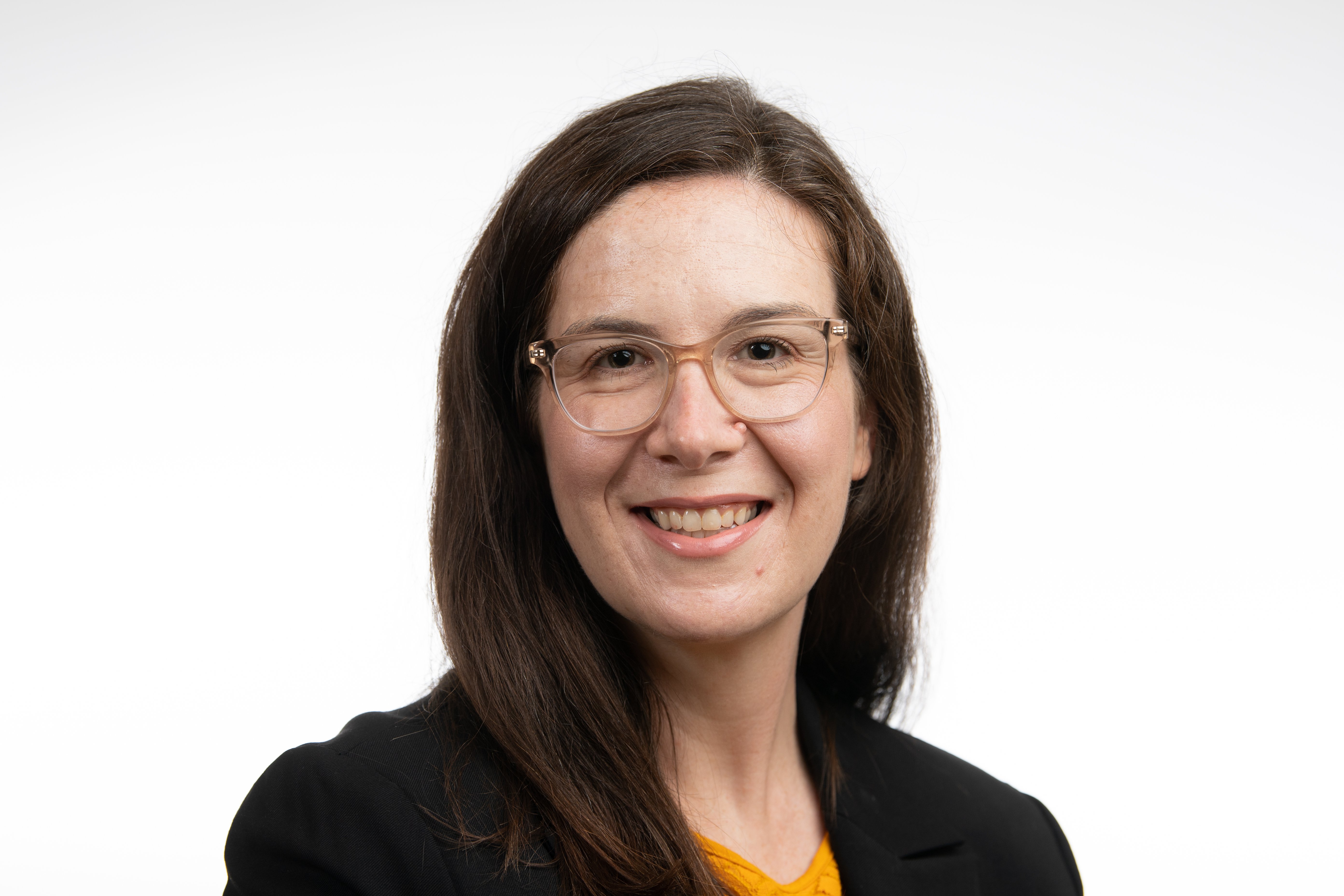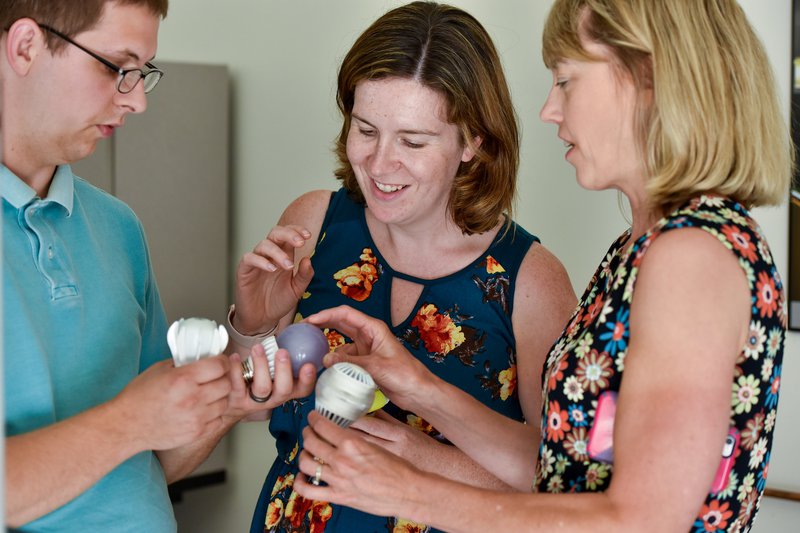Syracuse Alumna Recognized as Emerging Leader in Sustainable Energy
Karma Sawyer selected to join prestigious New Voices cohort at the National Academies of Sciences, Engineering, and Medicine.

When Karma Sawyer ’03 decided to study chemistry at Syracuse University’s College of Arts and Sciences (A&S), she wasn’t planning to pursue a career in sustainable energy and electricity infrastructure. But, after getting her doctorate in chemistry at the University of California, Berkeley, she wanted to find a way to leverage her academic background into applied work that could help address some of the most pressing environmental problems.
She’s now doing exactly that at Pacific Northwest National Lab (PNNL), a group that looks for innovative solutions to complex challenges in science and technology, especially in sustainable energy and national security. Sawyer is the division director of the Electricity Infrastructure and Buildings Division at PNNL, where she works on issues across energy efficiency, clean energy and electricity infrastructure. She manages a team of over 450 staff members and supports PNNL’s partnerships with groups like the Department of Energy (DOE) and the Department of Defense (DOD).
Sawyer’s work is geared around developing a more sustainable energy future, with fewer harmful emissions and greater energy efficiency across the energy system. She helps to advance PNNL’s clean energy and environmental goals through initiatives like decarbonizing buildings to lower greenhouse gas emissions and modernizing the electricity grid to be more flexible and resilient and integrating more renewable energy into energy systems used by buildings, vehicles and industry. She returned to Syracuse (virtually) in 2022 to lead a research and technology forum, Opportunities in Decarbonizing Buildings through Controls and Electrification at the Syracuse Center of Excellence, discussing these innovative approaches and opportunities related to technology transfer and user facilities at DOE National Labs, including PNNL.
She says this work is vital for a few key reasons, especially as energy is a critical component of our society and economy.
“The way we use and generate energy is changing,” she explains. “And there are a lot of complicated engineering problems that we are need to solve to ensure we can develop a more sustainable energy future to meet our energy needs.”
Sawyer explains that the US is simultaneously increasing the amount of variable renewable energy onto the grid, including solar and wind, while also electrifying loads, like heating buildings and powering transportation.
“We don’t have enough transmission to meet the new loads and we don’t have enough long-duration energy storage on the grid to operate it with all of the new variable renewables coming on line in the coming years.”

Karma Sawyer (center) at PNNL's Lighting Metrology Lab, where researchers develop energy-efficient lighting systems. (Image credit: Andrea Starr | Pacific Northwest National Laboratory).
“Historically, the grid has relied on large, centralized power plants, most of which have been powered with fossil fuels. Now we’re seeing more variable renewables coming online and replacing those centralized plants. We’re still learning how to plan, operate and control the grid with these new resources since the physics of the system will be fundamentally different.”
She adds that the climate is also changing and more extreme weather events are disrupting energy sources and needs – like when a drought hits a region and limits the amount of hydropower that’s available for use. And, she notes that marginalized communities are more affected by climate change and those disparities need to be considered in any potential solutions to energy issues.
“We need to make sure that all of the benefits of a new energy system impact marginalized communities in an equitable, fair and just way,” she says.
In recognition of her work in sustainable energy, Sawyer was recently selected to join the 2024–26 New Voices in Sciences, Engineering, and Medicine cohort at the National Academies of Sciences, Engineering, and Medicine, which aims to foster collaboration among emerging leaders working to address national and global challenges. In this role, Sawyer will help advise the National Academies on their work and promote STEM education.
“This is an incredible opportunity to engage in interdisciplinary, creative ideation with many fewer constraints than we typically encounter,” she says. “I’m so excited to engage with the group, learn from my peers across the world, and advance the mission of the National Academies of Sciences, Engineering, and Medicine.”
The cohort is in its early phases and Sawyer is still figuring out what she’ll be involved with during her two-year term. But she is already exploring ways to leverage her new position to do work in disability rights research and advocacy, an area she’s passionate about since she’s the mother of a child with a rare genetic condition.
“I think there is a lot of value in bringing my voice as a caregiver, alongside my experience running research programs for the federal government,” she says. “I’m hoping my perspective can help bring some attention to issues that affect many lives.”
While the jump from chemistry to energy involved some challenges, she trusted that she could continue learning throughout her career and appreciated the ways her career path did build on her academic background.
“There has always been a connection between the different phases my career,” she said. “The first work I did in energy was carbon capture, which directly leveraged my chemistry background, but allowed me to learn heat transfer principles as well. I then leveraged that as I moved into building materials.”
When she looks back at her time at Syracuse, she credits her chemistry education and training with helping her learn how to thoughtfully and methodically tackle long-term problems over the course of months and years, which remains a huge part of her work.
“My desire to solve big problems played a significant role in leading me to a career in energy, which is one of the biggest problems to address in our society,” she says.
She appreciated mentors like Karin Ruhlandt, Dean Emerita and Distinguished Professor of Chemistry, and Michael Sponsler, Professor and Director of Curricular Programs Forensics, who supported her and helped her realize she had potential in the field. She also developed important leadership and communication skills during her time at Syracuse, especially through her involvement with Alpha Chi Sigma, a professional chemistry fraternity that has a chapter at Syracuse.
“The longer I've spent working in science and engineering, the more I appreciate an ability to communicate across disciplinary boundaries and engage with people who don't have technical backgrounds,” she says. “That is a vital skill that makes people stand out in their career and science.”
If she was going to give advice to her younger self, she’d tell her to slow down and take the time to explore and grow, instead of being quite so intense and focused on her precise goals and plans.
“I think everyone should let themselves make mistakes and learn and see what comes of those lessons,” she says. “I also think there’s so much value in letting yourself enjoy challenges and pursue the chance to develop new skills.”
Media Contact
Emily Halnon
